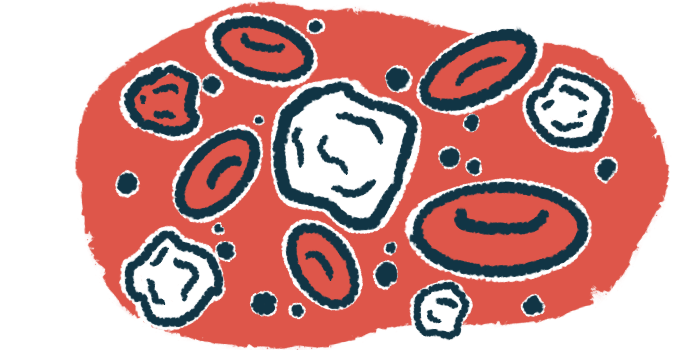B-cells containing CD226 may be Sjögren’s biomarker, therapy target
Study findings could offer 'new avenues for disease-modifying interventions'
Written by |

Immune B-cells that contain the receptor protein CD226 may play a role in the development and clinical manifestations of primary Sjögren’s disease, making CD226 a possible target for future treatments, a study reports.
Data indicated that people with Sjögren’s had proportionally more CD226-positive B-cells in their bloodstream than their healthy counterparts. The prevalence of these cells also correlated significantly with several biochemical and symptom-related markers of disease activity.
“Our findings highlight [CD226-positive] B cells as a potential therapeutic target and biomarker for [primary Sjögren’s disease], offering new avenues for disease-modifying interventions,” researchers wrote.
The study, “CD226+ B cells in primary Sjögren’s syndrome: a key player in clinical manifestations and disease pathogenesis,” was published in Frontiers in Immunology.
Team explores ties between CD226-positive cells, clinical features of Sjögren’s
In Sjögren’s disease, the immune system mistakenly attacks cells in the glands that produce tears and saliva, causing the characteristic symptoms of dry eyes and mouth. In primary Sjögren’s, this happens in the absence of an underlying autoimmune condition.
Immune B- and T-cells contribute to Sjögren’s and other autoimmune diseases. Some B-cells produce self-reactive antibodies that erroneously mark healthy tissue as potentially harmful. T-cells recognize and target the identified cells, leading to inflammation and other harmful processes.
A full-scale immune response typically involves both antibody recognition and the presence of other signaling molecules, called costimulators. CD226 is a receptor protein found on several immune cells, including B- and T-cells, that recognizes specific costimulators, promoting immune responses.
Previous studies have demonstrated that “CD226 is dysregulated on immune cells of peripheral blood and infiltrating tissue across autoimmune diseases, which contributes to disease progression in autoimmune disorders,” the research team wrote.
Although the team’s past work has suggested similar CD226 dysregulation in a subset of immune cells in Sjögren’s, little information is available about how the protein functions on B- and T-cells. In the present study, they tackled this question and the relationship between CD226-positive cells and the clinical features of Sjögren’s.
Treatments targeting CD226-positive B-cells could ease Sjögren’s symptoms
Forty individuals with primary Sjögren’s and 26 healthy controls participated in the study. Sjögren’s patients had an average age of 46.75 years, and 95% were women. None of them were receiving or had received medications to modulate the immune system’s activity.
Compared with healthy controls, Sjögren’s patients had significantly more CD226-positive cells across several immune cell types. These included multiple kinds of T-cells and B-cells containing CD19, a molecular marker of B-cells.
Several correlations existed between the proportion of these CD226-positive cells and various biochemical and symptomatic markers of Sjögren’s activity. However, only B-cells with CD226 had significant correlations with all measured activity variables, suggesting a strong relationship.
[CD226-positive CD19-positive] B cell[s] exhibited significant diagnostic capability to distinguish [primary Sjögren’s] patients from healthy controls and to differentiate disease activity.
They also found the percentage of B-cells that were positive for CD19 and CD226 was higher in people with active disease than in those with inactive disease. This suggests that with further validation, CD226 could serve as a biomarker of Sjögren’s.
“[CD226-positive CD19-positive] B cell[s] exhibited significant diagnostic capability to distinguish [primary Sjögren’s] patients from healthy controls and to differentiate disease activity,” the team wrote.
The team also noted a trend toward decreasing CD226-positive B-cells in seven participants after treatment. This trend wasn’t statistically significant in the small sample, but could suggest a role for CD226 in treatment response.
The researchers used human cells and animal models to examine molecular markers in B-cells with and without CD226 receptors. In Sjögren’s patients, CD226-positive cells had more costimulators and inflammatory signaling molecules called cytokines than CD226-negative cells. This was not seen in the case of healthy controls. Certain genes involved in immune signaling pathways also had higher activity levels in CD226-positive B-cells in a mouse model of Sjögren’s.
Based on these findings, the researchers suggested that CD226-positive B-cells contribute to sustained immune activity in primary Sjögren’s and may drive disease development. Because of this, they could serve as molecular markers of disease activity. They also hypothesized that treatments targeting CD226-positive B-cells could potentially ease Sjögren’s symptoms.
However, they noted the study didn’t establish if and how CD226 contributes to the disease on a molecular level.
“Further investigations are required to delineate the underlying molecular pathways, which may reveal more suitable immunomodulatory strategies and precise therapeutic targets for alleviating [primary Sjögren’s],” the team wrote.







